元宵节来历英语
元宵节的来历用英语写

The Origin of Lantern FestivalIntroductionLantern Festival, also known as Yuanxiao Festival, is a traditional Chinese festival celebrated on the fifteenth day of the first lunar month. It marks the end of the Spring Festival and is considered one of the most important occasions in Chinese culture. This document aims to explore the origin and cultural significance of the Lantern Festival.Historical BackgroundThe Lantern Festival has a history of over 2,000 years and is deeply rooted in Chinese folklore and traditions. Its beginnings can be traced back to the Western Han Dynasty (206 BC – 9 AD) when the Han Emperor Wudi officially recognized it as a festival. However, the customs and rituals associated with the festival can be found even earlier during the Eastern Han Dynasty (25–220 AD).Origin StoriesThere are several popular stories and legends associated with the origin of Lantern Festival:Celebrating Lunar New YearOne theory suggests that the Lantern Festival originated as a way to celebrate the completion of the Lunar New Year festivities. It was believed that on this day, the gods and celestial beings would descend to earth to bless the people. In order to guide them and showcase their joy and happiness, people began to light lanterns and set off fireworks.Honoring the Deity TianguanAnother legend is related to the deity Tianguan. In ancient times, people believed that the deity controlled human destiny and could ward off evil spirits. To express their gratitude and seek blessings from Tianguan, people would gather on the fifteenth day of the first lunar month to release lanterns and pray for good fortune.Commemorating Taoist DeitiesIn Taoist mythology, the fifteenth day of the first lunar month was believed to be the birthday of Tianguan, the God of Heaven. People would make offerings to various Taoist deities and pray for blessings. The Lantern Festival became a way to honor these deities and seek their protection.Traditional Customs and ActivitiesThe Lantern Festival is known for its vibrant celebrations and various activities. The following are some of the most common customs associated with the festival: Lantern DisplaysDuring the festival, decorative lanterns are hung in public places, parks, and temples. These lanterns come in various shapes and sizes, showcasing intricate designs and vibrant colors. They are often made of paper or silk and are lit up by candles or electric bulbs.Lantern Riddle GuessingA popular activity during the Lantern Festival is guessing lantern riddles. Riddles are written on lanterns, and people have to solve them to win prizes. This tradition adds an element of fun and intellectual challenge to the festival.Lion and Dragon DancesLion and dragon dances are an integral part of the Lantern Festival. Performers dress up as lions or dragons and dance their way through the streets, accompanied by the beat of drums and cymbals. These dances are believed to bring good luck and chase away evil spirits.Eating TangyuanTangyuan, also known as yuanxiao in the north, is a type of sweet glutinous rice ball. It is a traditional food consumed during the Lantern Festival. These rice dumplings are usually filled with sweet fillings such as sesame paste, red bean paste, or peanut butter, and are boiled and served in a sweet soup.Cultural SignificanceThe Lantern Festival holds great cultural significance in Chinese society. It represents the unity of family and the coming together of loved ones. It is a time for people to express their hopes and dreams for the new year and to pray for blessings and good fortune. The festival also promotes traditional arts and crafts, such as lantern making and riddle writing, which have been passed down through generations.ConclusionThe Lantern Festival is not only a time for celebration but also a reflection of Chinese history, culture, and traditions. Its origin stories, customs, and activities all contribute to the unique charm of this festival. As the lanterns illuminate the night sky, the festival brings people together, spreading joy, harmony, and good fortune.。
元宵节的来历起源英文
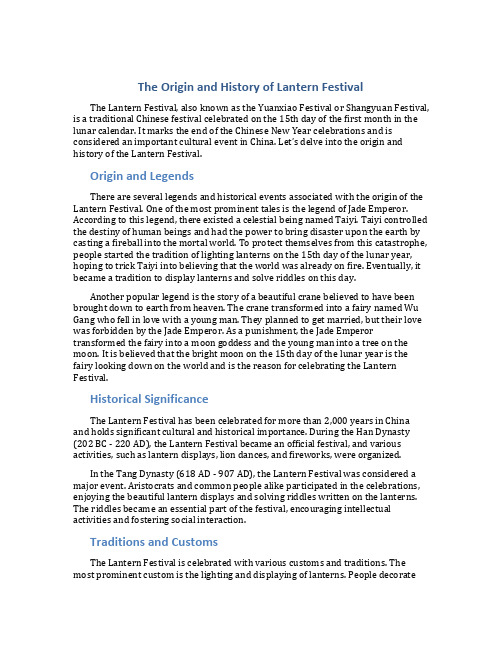
The Origin and History of Lantern Festival The Lantern Festival, also known as the Yuanxiao Festival or Shangyuan Festival, is a traditional Chinese festival celebrated on the 15th day of the first month in the lunar calendar. It marks the end of the Chinese New Year celebrations and is considered an important cultural event in China. Let’s delve into the origin and history of the Lantern Festival.Origin and LegendsThere are several legends and historical events associated with the origin of the Lantern Festival. One of the most prominent tales is the legend of Jade Emperor. According to this legend, there existed a celestial being named Taiyi. Taiyi controlled the destiny of human beings and had the power to bring disaster upon the earth by casting a fireball into the mortal world. To protect themselves from this catastrophe, people started the tradition of lighting lanterns on the 15th day of the lunar year, hoping to trick Taiyi into believing that the world was already on fire. Eventually, it became a tradition to display lanterns and solve riddles on this day.Another popular legend is the story of a beautiful crane believed to have been brought down to earth from heaven. The crane transformed into a fairy named Wu Gang who fell in love with a young man. They planned to get married, but their love was forbidden by the Jade Emperor. As a punishment, the Jade Emperor transformed the fairy into a moon goddess and the young man into a tree on the moon. It is believed that the bright moon on the 15th day of the lunar year is the fairy looking down on the world and is the reason for celebrating the Lantern Festival.Historical SignificanceThe Lantern Festival has been celebrated for more than 2,000 years in China and holds significant cultural and historical importance. During the Han Dynasty (202 BC - 220 AD), the Lantern Festival became an official festival, and various activities, such as lantern displays, lion dances, and fireworks, were organized.In the Tang Dynasty (618 AD - 907 AD), the Lantern Festival was considered a major event. Aristocrats and common people alike participated in the celebrations, enjoying the beautiful lantern displays and solving riddles written on the lanterns. The riddles became an essential part of the festival, encouraging intellectual activities and fostering social interaction.Traditions and CustomsThe Lantern Festival is celebrated with various customs and traditions. The most prominent custom is the lighting and displaying of lanterns. People decoratetheir houses and streets with lanterns of different shapes and sizes, creating a festive atmosphere. In addition to lantern displays, dragon and lion dances are also performed during the Lantern Festival, adding to the excitement and vibrancy of the celebrations.Another important tradition is solving riddles written on lanterns. Riddles are written on small strips of paper and attached to lanterns. People are challenged to solve these riddles, and those who succeed are often rewarded with small prizes. This custom not only adds an element of fun but also promotes critical thinking and cultural exchange.Traditionally, eating tangyuan (sweet glutinous rice balls) is also an integral part of the Lantern Festival. Tangyuan is round and symbolizes reunion, completeness, and harmony. Families gather together to enjoy this special treat and celebrate togetherness.In recent years, the Lantern Festival has extended beyond China and is celebrated by people of Chinese descent around the world. It serves as a bridge connecting Chinese culture and other cultures, promoting multicultural exchanges and fostering understanding and appreciation of Chinese traditions.ConclusionThe Lantern Festival has a rich history and cultural significance in China. With its beautiful lantern displays, riddle-solving customs, and rich traditions, the festival provides an opportunity to celebrate togetherness, promote intellectual activities, and preserve Chinese cultural heritage. The traditions associated with the Lantern Festival continue to flourish and evolve, making it a cherished festival that symbolizes unity and joy for people of Chinese descent all around the world.。
元宵节的来历英文版

元宵节的来历英⽂版元宵节的来历英⽂版 元宵节是我国的传统佳节之⼀,下⾯YJBYS⼩编为⼤家精⼼搜集了关于英⽂版的元宵节来历,欢迎⼤家参考借鉴,希望可以帮助到⼤家! 元宵节 lantern festival 元宵节 it comes on the 15th of the first lunar month and it marks the end of the spring festival. on this day, people often eat sweet dumplings(元宵)for good luck. they will visit the display of lanterns(灯展)or go for temple fair(庙会) 元宵节的来历 lantern festival lantern festival falls on the fifteenth day of the first lunar month. this is the first full moon of the new year, symbolizing unity and perfection. lantern festival is an important part of spring festival , and marks the official end of the long holiday. 元宵节是农历正⽉的第⼗五天,这是新年的第⼀次满⽉,象征着和睦和团圆。
元宵节是春节的⼀个重要组成部分,也象征着春节长假的正式结束。
there are many legends concerning the origins of lantern festival. 关于元宵节的来历有很多传说。
according to one legend, once in ancient times, a celestial swan came into the mortal world where it was shot down by a hunter. the jade emperor, the highest god in heaven, vowed to avenge the swan. he started making plans to send a troop of celestial soldiers and generals to earth on the fifteenth day of the first lunar month, with orders to incinerate all humans and animals. but the other celestial beings disagreed with this course of action, and risked their lives to warn the people of earth. as a result, before and after the fifteenth day of the first month, every family hung red lanterns outside their doors and set off firecrackers and fireworks, giving the impression that their homes were already burning. by successfully tricking the jade emperor in this way, humanity was saved from extermination. 有⼀个传说是这样的,在古代,有⼀位神界天鹅闯⼊⼈间被猎⼿误杀。
元宵节的来历英语简短
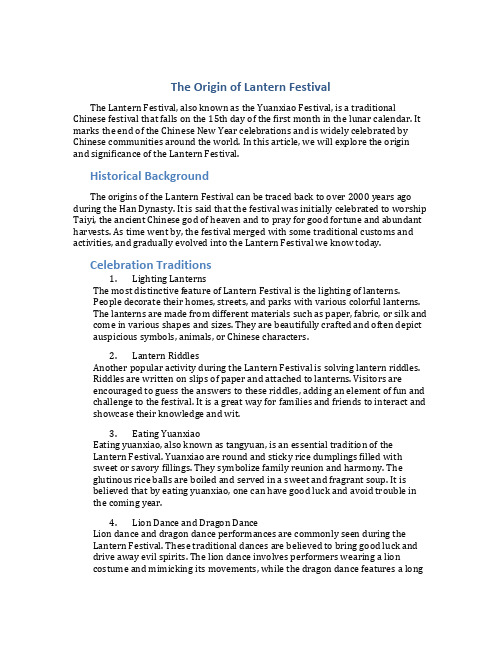
The Origin of Lantern FestivalThe Lantern Festival, also known as the Yuanxiao Festival, is a traditional Chinese festival that falls on the 15th day of the first month in the lunar calendar. It marks the end of the Chinese New Year celebrations and is widely celebrated by Chinese communities around the world. In this article, we will explore the origin and significance of the Lantern Festival.Historical BackgroundThe origins of the Lantern Festival can be traced back to over 2000 years ago during the Han Dynasty. It is said that the festival was initially celebrated to worship Taiyi, the ancient Chinese god of heaven and to pray for good fortune and abundant harvests. As time went by, the festival merged with some traditional customs and activities, and gradually evolved into the Lantern Festival we know today.Celebration Traditions1.Lighting LanternsThe most distinctive feature of Lantern Festival is the lighting of lanterns.People decorate their homes, streets, and parks with various colorful lanterns.The lanterns are made from different materials such as paper, fabric, or silk and come in various shapes and sizes. They are beautifully crafted and often depict auspicious symbols, animals, or Chinese characters.ntern RiddlesAnother popular activity during the Lantern Festival is solving lantern riddles.Riddles are written on slips of paper and attached to lanterns. Visitors areencouraged to guess the answers to these riddles, adding an element of fun and challenge to the festival. It is a great way for families and friends to interact and showcase their knowledge and wit.3.Eating YuanxiaoEating yuanxiao, also known as tangyuan, is an essential tradition of theLantern Festival. Yuanxiao are round and sticky rice dumplings filled withsweet or savory fillings. They symbolize family reunion and harmony. Theglutinous rice balls are boiled and served in a sweet and fragrant soup. It isbelieved that by eating yuanxiao, one can have good luck and avoid trouble in the coming year.4.Lion Dance and Dragon DanceLion dance and dragon dance performances are commonly seen during theLantern Festival. These traditional dances are believed to bring good luck and drive away evil spirits. The lion dance involves performers wearing a lioncostume and mimicking its movements, while the dragon dance features a longdragon made of fabric, supported by multiple dancers. The vibrant music and energetic dance moves create an exciting atmosphere during the festival.Symbolism and SignificanceThe Lantern Festival holds deep cultural and spiritual significance in Chinese society. The lanterns symbolize a bright and prosperous future, conveying wishes for a successful year ahead. The riddles on the lanterns are seen as an exercise for the mind, promoting intellectual stimulation and knowledge-sharing. Eating yuanxiao is not only a culinary delight but also a symbol of unity and togetherness among family members.Furthermore, as the Lantern Festival takes place on the first full moon night of the Chinese New Year, it also represents the reunion of loved ones. This aspect of the festival is particularly cherished by those who live far away from their families. The event provides an opportunity for families to gather, share meals, and enjoy various activities together.ConclusionThe Lantern Festival, with its rich historical roots and festive traditions, is an integral part of Chinese culture. It brings joy, unity, and hope to people, as they celebrate the end of the Chinese New Year and look forward to a brighter future. The beautiful lanterns, captivating performances, and mouthwatering yuanxiao create a lively and enchanting atmosphere during this auspicious festival.。
元宵节由来英文介绍
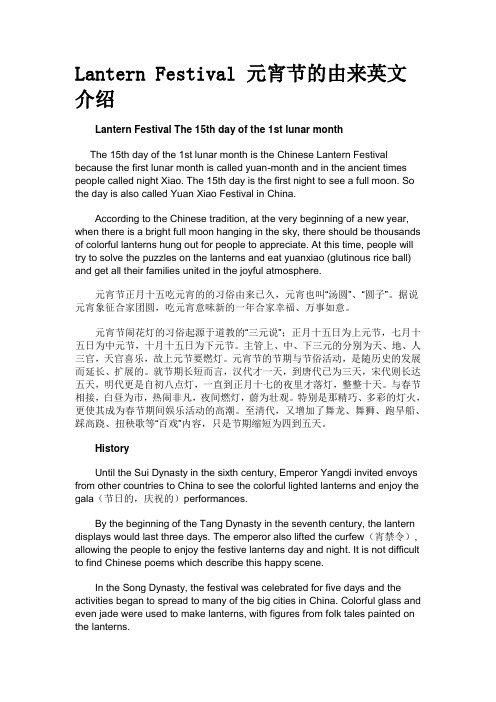
Lantern Festival 元宵节的由来英文介绍Lantern Festival The 15th day of the 1st lunar monthThe 15th day of the 1st lunar month is the Chinese Lantern Festival because the first lunar month is called yuan-month and in the ancient times people called night Xiao. The 15th day is the first night to see a full moon. So the day is also called Yuan Xiao Festival in China.According to the Chinese tradition, at the very beginning of a new year, when there is a bright full moon hanging in the sky, there should be thousands of colorful lanterns hung out for people to appreciate. At this time, people will try to solve the puzzles on the lanterns and eat yuanxiao (glutinous rice ball) and get all their families united in the joyful atmosphere.元宵节正月十五吃元宵的的习俗由来已久,元宵也叫“汤圆”、“圆子”。
据说元宵象征合家团圆,吃元宵意味新的一年合家幸福、万事如意。
元宵节闹花灯的习俗起源于道教的“三元说”;正月十五日为上元节,七月十五日为中元节,十月十五日为下元节。
元宵节由来英文介绍
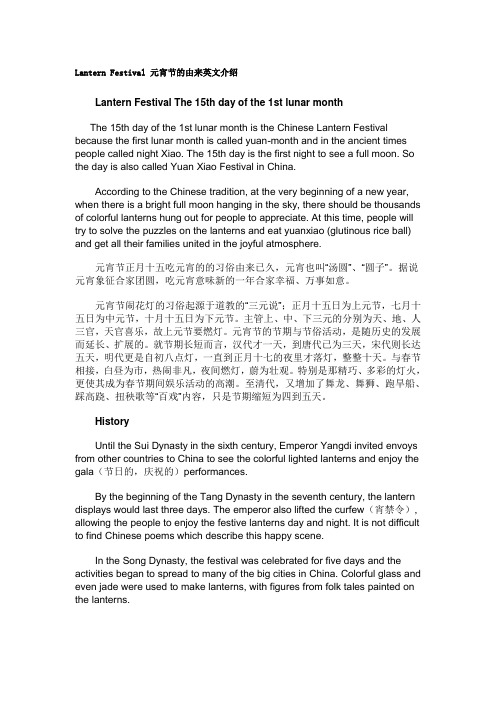
Lantern Festival 元宵节的由来英文介绍Lantern Festival The 15th day of the 1st lunar monthThe 15th day of the 1st lunar month is the Chinese Lantern Festival because the first lunar month is called yuan-month and in the ancient times people called night Xiao. The 15th day is the first night to see a full moon. So the day is also called Yuan Xiao Festival in China.According to the Chinese tradition, at the very beginning of a new year, when there is a bright full moon hanging in the sky, there should be thousands of colorful lanterns hung out for people to appreciate. At this time, people will try to solve the puzzles on the lanterns and eat yuanxiao (glutinous rice ball) and get all their families united in the joyful atmosphere.元宵节正月十五吃元宵的的习俗由来已久,元宵也叫“汤圆”、“圆子”。
据说元宵象征合家团圆,吃元宵意味新的一年合家幸福、万事如意。
元宵节闹花灯的习俗起源于道教的“三元说”;正月十五日为上元节,七月十五日为中元节,十月十五日为下元节。
英文版元宵节的来历介绍
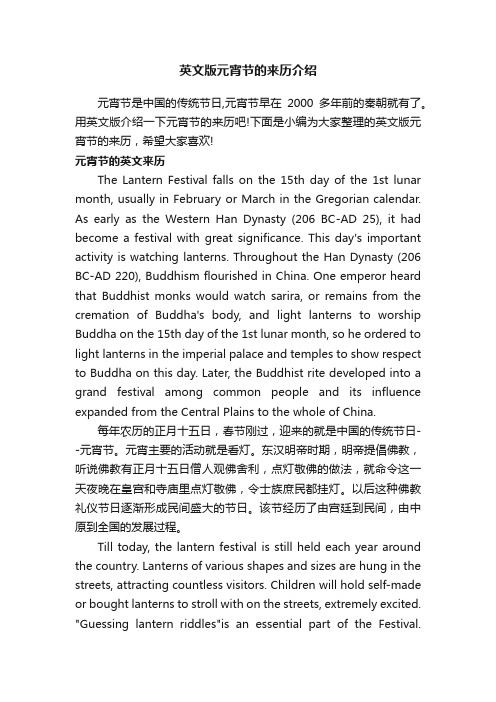
英文版元宵节的来历介绍元宵节是中国的传统节日,元宵节早在2000多年前的秦朝就有了。
用英文版介绍一下元宵节的来历吧!下面是小编为大家整理的英文版元宵节的来历,希望大家喜欢!元宵节的英文来历The Lantern Festival falls on the 15th day of the 1st lunar month, usually in February or March in the Gregorian calendar. As early as the Western Han Dynasty (206 BC-AD 25), it had become a festival with great significance. This day's important activity is watching lanterns. Throughout the Han Dynasty (206 BC-AD 220), Buddhism flourished in China. One emperor heard that Buddhist monks would watch sarira, or remains from the cremation of Buddha's body, and light lanterns to worship Buddha on the 15th day of the 1st lunar month, so he ordered to light lanterns in the imperial palace and temples to show respect to Buddha on this day. Later, the Buddhist rite developed into a grand festival among common people and its influence expanded from the Central Plains to the whole of China.每年农历的正月十五日,春节刚过,迎来的就是中国的传统节日--元宵节。
元宵节的来历英文表达
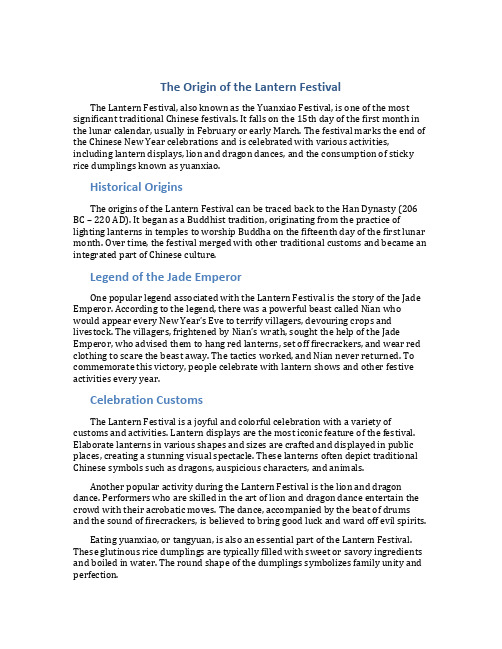
The Origin of the Lantern FestivalThe Lantern Festival, also known as the Yuanxiao Festival, is one of the most significant traditional Chinese festivals. It falls on the 15th day of the first month in the lunar calendar, usually in February or early March. The festival marks the end of the Chinese New Year celebrations and is celebrated with various activities, including lantern displays, lion and dragon dances, and the consumption of sticky rice dumplings known as yuanxiao.Historical OriginsThe origins of the Lantern Festival can be traced back to the Han Dynasty (206 BC – 220 AD). It began as a Buddhist tradition, originating from the practice of lighting lanterns in temples to worship Buddha on the fifteenth day of the first lunar month. Over time, the festival merged with other traditional customs and became an integrated part of Chinese culture.Legend of the Jade EmperorOne popular legend associated with the Lantern Festival is the story of the Jade Emperor. According to the legend, there was a powerful beast called Nian who would a ppear every New Year’s Eve to terrify villagers, devouring crops and livestock. The villagers, frightened by Nian’s wrath, sought the help of the Jade Emperor, who advised them to hang red lanterns, set off firecrackers, and wear red clothing to scare the beast away. The tactics worked, and Nian never returned. To commemorate this victory, people celebrate with lantern shows and other festive activities every year.Celebration CustomsThe Lantern Festival is a joyful and colorful celebration with a variety of customs and activities. Lantern displays are the most iconic feature of the festival. Elaborate lanterns in various shapes and sizes are crafted and displayed in public places, creating a stunning visual spectacle. These lanterns often depict traditional Chinese symbols such as dragons, auspicious characters, and animals.Another popular activity during the Lantern Festival is the lion and dragon dance. Performers who are skilled in the art of lion and dragon dance entertain the crowd with their acrobatic moves. The dance, accompanied by the beat of drums and the sound of firecrackers, is believed to bring good luck and ward off evil spirits.Eating yuanxiao, or tangyuan, is also an essential part of the Lantern Festival. These glutinous rice dumplings are typically filled with sweet or savory ingredients and boiled in water. The round shape of the dumplings symbolizes family unity and perfection.Modern CelebrationsIn addition to the traditional customs, modern Lantern Festival celebrations have incorporated various innovative elements. Nowadays, lantern shows often feature advanced technology, including LED lights and animated displays. Some large-scale lantern festivals also include music performances, traditional folk dances, and art exhibitions to entertain visitors.The Lantern Festival has gained recognition beyond China’s borders and is celebrated by Chinese communities around the world. It not only showcases the rich cultural heritage of China but also promotes cultural exchange and understanding.ConclusionThe Lantern Festival, with its rich history and vibrant customs, is not only a time for family reunions but also a celebration of cultural identity. The lantern displays, lion and dragon dances, and the indulgence in yuanxiao create a festive atmosphere filled with joy and unity. This traditional Chinese festival continues to evolve, blending ancient customs with modern innovations and captivating people from all walks of life.。
元宵节的来历英语版简短介绍

Introduction to the Origins of the Lantern Festival The Lantern Festival, also known as the Yuanxiao Festival, is a traditional Chinese festival that marks the end of the Chinese New Year celebrations. It falls on the 15th day of the first month of the Chinese lunar calendar, which usually falls in February or early March.Historical BackgroundThe origins of the Lantern Festival can be traced back to the Eastern Han Dynasty (25-220 AD). During this time, Buddhism was gaining popularity in China, and Emperor Ming of Han adopted the tradition of lighting lanterns in Buddhist temples to show respect for Buddha. As time went on, this tradition spread to the common people, and lighting lanterns became a popular activity during the festival.Celebrating the Lantern FestivalIn China, the Lantern Festival is celebrated with various traditional activities and customs. The most iconic feature of the festival is the use of lanterns, which are often handcrafted and beautifully decorated. These lanterns come in all shapes and sizes, and are often placed along streets, in parks, or in temples. The sight of thousands of colorful lanterns lighting up the night sky is truly a mesmerizing sight.Another popular activity during the Lantern Festival is solving riddles. Riddles are written on slips of paper and attached to lanterns. People gather around the lanterns, read the riddles, and try to solve them. It is believed that solving the riddles brings good luck and wisdom for the upcoming year.The Legend of YuanxiaoThe Lantern Festival is also closely associated with the legend of Yuanxiao. According to the legend, there was a beautiful woman named Yuanxiao who lived during the Eastern Han Dynasty. She was the daughter of a Chef who worked in the imperial palace. One day, Yuanxiao was informed that the Emperor planned to execute the entire city on the 15th day of the first lunar month.Distressed by this news, Yuanxiao came up with a plan to save the city. She wrote her address and the date of the massacre on little slips of paper, and then handed them out to the citizens. She instructed them to put the slips of paper into their rice balls and eat them on the night of the 15th day of the first lunar month.On the night of the planned massacre, the streets were filled with people eating the rice balls as instructed by Yuanxiao. Suddenly, colorful lanterns rose into the sky, and the sounds of firecrackers filled the air. The Emperor, seeing the celebration happening throughout the city, realized that his plans had been foiled. He decided to release the city and spare the lives of its inhabitants.From that day on, the 15th day of the first lunar month became known as Yuanxiao Festival and the rice balls eaten during the festival were named after her.ConclusionThe Lantern Festival is a joyful celebration that brings communities together. It is a time to appreciate the beauty of lanterns, to enjoy solving riddles, and to remember the legend of Yuanxiao. As one of the most vibrant and exciting festivals in China, the Lantern Festival is beloved by people of all ages and continues to be celebrated with great enthusiasm to this day.。
元宵节的由来英语介绍是什么
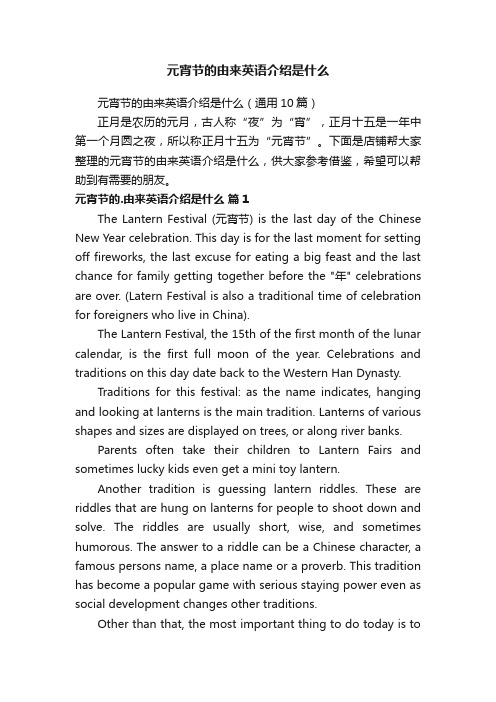
元宵节的由来英语介绍是什么元宵节的由来英语介绍是什么(通用10篇)正月是农历的元月,古人称“夜”为“宵”,正月十五是一年中第一个月圆之夜,所以称正月十五为“元宵节”。
下面是店铺帮大家整理的元宵节的由来英语介绍是什么,供大家参考借鉴,希望可以帮助到有需要的朋友。
元宵节的.由来英语介绍是什么篇1The Lantern Festival (元宵节) is the last day of the Chinese New Year celebration. This day is for the last moment for setting off fireworks, the last excuse for eating a big feast and the last chance for family getting together before the "年" celebrations are over. (Latern Festival is also a traditional time of celebration for foreigners who live in China).The Lantern Festival, the 15th of the first month of the lunar calendar, is the first full moon of the year. Celebrations and traditions on this day date back to the Western Han Dynasty.Traditions for this festival: as the name indicates, hanging and looking at lanterns is the main tradition. Lanterns of various shapes and sizes are displayed on trees, or along river banks.Parents often take their children to Lantern Fairs and sometimes lucky kids even get a mini toy lantern.Another tradition is guessing lantern riddles. These are riddles that are hung on lanterns for people to shoot down and solve. The riddles are usually short, wise, and sometimes humorous. The answer to a riddle can be a Chinese character, a famous persons name, a place name or a proverb. This tradition has become a popular game with serious staying power even as social development changes other traditions.Other than that, the most important thing to do today is toeat sweet dumplings. In northern China, sweet dumplings made of glutinous rice flour are called "元宵" while in southern part they are called "汤圆". Typical sweet dumplings are filled with black sesame sauce, sweetened bean paste, or hawthorn. Making "元宵" today is like a game or an activity, so its seldom done without a reason and a group of friends or family present to help out.元宵节的由来英语介绍是什么篇2The Lantern Festival, which occurs on the 15-th day of the First Month of theChinese Year, marks the end of the New Year's Holidays.Lanterns are everywhere. A most interesting tradition is the posting ofriddles called 'Lantern Riddles.' Riddles are written on pieces of paper andposted on lanterns or wall. Any one solving the riddle is awarded a prize.and the food for lantern festival is T ang Yuan, i have made some Tang Yuanin a ginger soup, my wife got a serious cold, so i cooked a pot of ginger soupfor her. i look forward to the next spring festival元宵节的由来英语介绍是什么篇3Festival of Lanterns.I spent the Festival of Lanterns with my grandparents this year.My family went to my grandparents‘ home and had dinner with them.We had lots of sweetdumplins.After the dinner, my grandparents and I went out to play fireworks.We had a very good time together.元宵节的由来英语介绍是什么篇4On the 15th day of the first lunar month, the Lantern Festival is celebrated on the Lantern Festival. Our school is no exception, each student eats two big rice dumplings. The teacher said: "the students who eat the red jujube can get an unexpected gift, andcan also take a photo as a souvenir."Before eating yuanxiao I silently pray: red date ah red date you will I hide in my yuanxiao? And that lucky fellow won't be me?I took the first yuanxiao to bite down, alas! It was bean paste, but very sweet, I think: there is a little hope, I did not hesitate to pick up the second yuanxiao can't wait to bite down, the luck is really bad, is the food, but very fragrant.Although today did not eat the red date of the Lantern Festival, but I am also very happy, because I and the teacher, the students in the New Year happily passed a lively Lantern Festival! 元宵节的由来英语介绍是什么篇5Lantern Festival is the first full moon day of the year, it symbolizes reunion, harmony and good. But some people are far away from their hometown, relatives, such as armed police soldiers, they for the sake of the countrys peace, silently stick to their posts.In order to send joy and blessings to the armed police uncles far away from home. On the Lantern Festival, our school "child eagle" traffic police club organized us to celebrate the festival with the armed police uncles. We first came to the scene under the leadership of the community staff. As soon as we arrived at the production stage, we couldnt wait to wash our hands while learning the appearance of the aunt mother-in-law rubbed up the Lantern Festival, while with excitement waiting for the arrival of the armed police uncles, "to come to!" I do not know who shouted, I saw the armed police uncle walked neatly toward us. As soon as they entered the door, they put their hats neatly on the table, and then together with us to rub up the yuanxiao. After a while, a round yuanxiao was rubbed."All right, all right! With the cries of the community mother-in-law. A bowl of steaming yuanxiao in front of us, we quickly put the yuanxiao end to the armed police uncle hand, they give and take to each other...... Looking at the happy smiling faces of our uncles and eating the yuanxiao made by ourselves, our hearts are full of pride.Time flies like an arrow. The armed police uncles are going back to the brigade. We quickly stood in a row, loudly said: "armed police uncle goodbye, happy Lantern Festival, see you again!" Everyone laughed.This is really an unforgettable Lantern Festival ah!元宵节的由来英语介绍是什么篇6The Lantern Festival is a traditional festival in our country. Once the Lantern Festival is over, the Spring Festival is over, so this day is very ceremonious and lively. The main activities of people on this day are dragon dancing, lion dancing, setting off firecrackers and the more important is watching fireworks.At more than 7 o clock in the evening, I was in a hurry to call my aunt took me to the Lantern Festival to see fireworks, on the road I saw a lot of people like me want to see fireworks, we all old and small family, seemed very happy.To the yuanxiao field people mountain people sea, drums and gongs, but lively.Only heard a few dull voice, a fireworks with red Mars fled on the sky, a few crisp sound, the night sky blooming out of a few beautiful flowers. Their shapes and colors are not the same, there are colorful stars, golden dandelion, purple morning glory, silver lily...... Colorful. How beautiful!In the crisp sound of fireworks, people slightly raised a happy smile on the face!元宵节的由来英语介绍是什么篇7After eating yuanxiao, we came to the top of the building, the big and round moon high in the sky and we watch fireworks, here is a good place to watch fireworks."Bang" a blunt sound, a big chrysanthemum in the air suddenly open, blooming from the core of countless colorful petals, suddenly the beautiful night sky decorated more colorful. Then a blossoming of different colors of fireworks in the sky race to open first, competing for beauty, some like a machine gun to the sky, some like swimming in the sky starfish, some like coconut trees, and like fireflies flying aimlessly in the sky...... Again heard "bang" sound, a large fireworks burst, jumped out of countless small dots, then countless small dots into countless small mushrooms, they like a small paratrooper falling down from the air. At this time, a huge willow tree from the sky, like gold waterfall flowing down, is really "flying down three thousand feet, suspected to be the Milky Way nine days." We are intoxicated in this colorful world. Dad suddenly said: "today, even if the year is over, from tomorrow you will start school." Just then, a meteor across the sky, I quickly made a wish.Today, I am so happy!元宵节的由来英语介绍是什么篇8Today is the Lantern Festival, in order to go to see the Lantern Festival early, I eat faster. To the north of the city park a look, here is really a sea of people, has become a sea of joy.I wanted to see the dragon dance, but there were too many people to squeeze in, so we had to go to the amusement park first. Playing for a while, my mother suddenly saw a big light, I was attracted by it, also ran past. Its so big, taller than Dad! Below is a small boat, above is a big bull, meaning we in this year of the ox smooth sailing.The air was hung with all kinds of lights. There are lotus lamp, fish lamp, Jade Rabbit lamp, octagonal palace lamp...... They line up in a row, like a river of lights, the whole park are shining glittering and translucent bright.Looked up, a big and round moon hanging in the sky, there are countless lanterns rising slowly. The Kongming Lantern was invented by Zhuge Kongming in the Three Kingdoms Period, also called wishing lamp, which brings good luck and happiness to people.This is really: bright light beautiful people happy, happy night Lion Dance Longfei.元宵节的由来英语介绍是什么篇9Lantern Festival is a traditional Chinese festival,the first month of the Lunar New Year celebration of the fifteenth ntern Festival is one of the largest festivals.A few days before the arrival of the Lantern Festival,people begin to make lanterns,animals,vegetables,fruits,all kinds of all,there are riddles.The eve of the Lantern Festival,all the lanterns are ntern Festival,one look at the lanterns and riddles,wonderful folk performances,Dragon Dance and Younger.元宵节是中国的一个传统节日,在农历的新年第一个月的第十五天庆祝。
元宵节来历英语

元宵节来历英语【篇一:元宵节lantern festival由来中英文翻译】元宵节自汉朝 (公元前 206 年—公元 221 年)起,元宵节就已成为了中国新年庆贺活动中的一部分了。
一般阴历的正月十五为元宵节,这天也标记着新年庆贺活动的结束。
the lantern festival has been part of chinese new year celebrations since the han dynasty (206 bc- 221 ad). usuallyheld on the 15th day of the first month of the lunar calendar, itmarks the end of new year festivities。
听说元宵节由古代中国的一个传说演化而来,传言每至阴历第一个月圆之夜,即可看到天上飞动的神灵。
为了更简单找寻神灵,他们都会用一些火把照明,而这些火把也渐渐由一些形状、大小、颜色各异的灯笼所代替。
it is said that the holiday evolved from an ancient chinesebelief that celestial spirits could be seen flying about in thelight of the first full moon of the lunar calendar. to aid them intheir search for the spirits they used torches. these torchesgave way to lanterns of every shape, size and colour。
元宵节广受喜欢的另一个原由在于:它也被看做中国的情人节,由于在过去,这天少男少女们能够利用这个可贵的时机夜晚一同出去约会。
现在,在中国、香港、新加坡和台湾每年都会欢庆元宵节,以此作为中国新年庆贺的扫尾。
元宵节的来历英文翻译
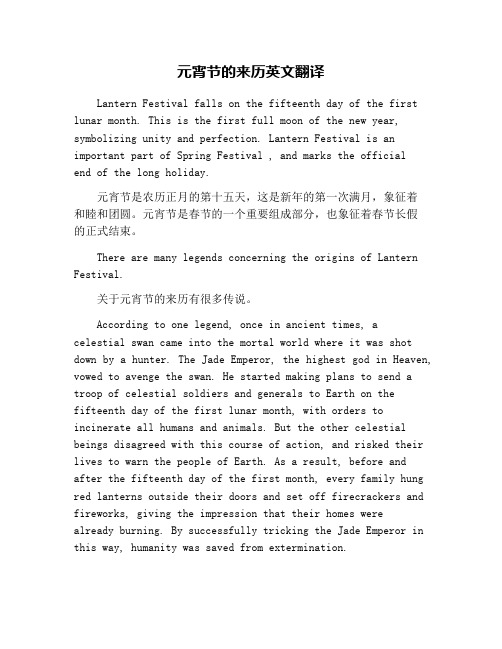
元宵节的来历英文翻译Lantern Festival falls on the fifteenth day of the first lunar month. This is the first full moon of the new year, symbolizing unity and perfection. Lantern Festival is an important part of Spring Festival , and marks the officialend of the long holiday.元宵节是农历正月的第十五天,这是新年的第一次满月,象征着和睦和团圆。
元宵节是春节的一个重要组成部分,也象征着春节长假的正式结束。
There are many legends concerning the origins of Lantern Festival.关于元宵节的来历有很多传说。
According to one legend, once in ancient times, acelestial swan came into the mortal world where it was shot down by a hunter. The Jade Emperor, the highest god in Heaven, vowed to avenge the swan. He started making plans to send a troop of celestial soldiers and generals to Earth on the fifteenth day of the first lunar month, with orders to incinerate all humans and animals. But the other celestial beings disagreed with this course of action, and risked their lives to warn the people of Earth. As a result, before andafter the fifteenth day of the first month, every family hung red lanterns outside their doors and set off firecrackers and fireworks, giving the impression that their homes werealready burning. By successfully tricking the Jade Emperor in this way, humanity was saved from extermination.有一个传说是这样的,在古代,有一位神界天鹅闯入人间被猎手误杀。
元宵节的来历英语30字

元宵节的来历英语30字英文回答:The Lantern Festival, also known as Shangyuan Festival, originated in China over 2,000 years ago during the Western Han Dynasty (206 B.C.-25 A.D.). It is celebrated on the15th day of the first lunar month, which usually falls in February or March. The festival marks the end of the Chinese New Year celebrations and is a time for families to gather and celebrate.The lantern festival is said to have originated from the Buddhist tradition of lighting lanterns to guide the spirits of the deceased back to their homes. Over time, the festival became a more secular event, and lanterns were used to celebrate the arrival of spring and to ward offevil spirits.Today, the Lantern Festival is celebrated with avariety of activities, including lantern displays,fireworks, and lion dances. In many parts of China, people also eat yuanxiao, a type of glutinous rice ball that is filled with sweet or savory fillings.中文回答:元宵节,又称上元节,起源于2000多年前的汉朝。
元宵节的来历英文介绍
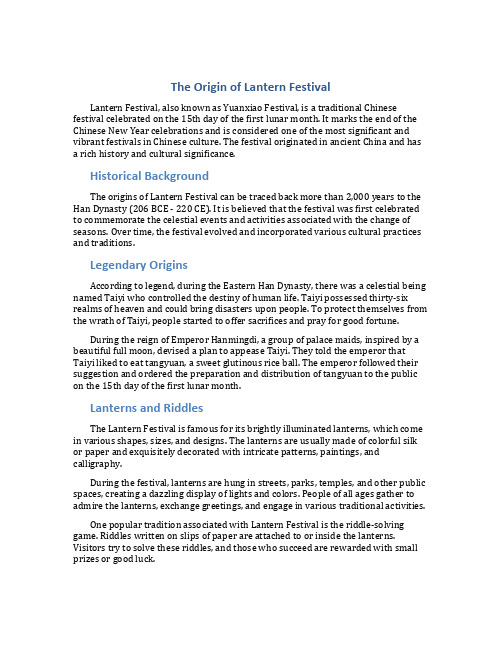
The Origin of Lantern FestivalLantern Festival, also known as Yuanxiao Festival, is a traditional Chinese festival celebrated on the 15th day of the first lunar month. It marks the end of the Chinese New Year celebrations and is considered one of the most significant and vibrant festivals in Chinese culture. The festival originated in ancient China and has a rich history and cultural significance.Historical BackgroundThe origins of Lantern Festival can be traced back more than 2,000 years to the Han Dynasty (206 BCE - 220 CE). It is believed that the festival was first celebrated to commemorate the celestial events and activities associated with the change of seasons. Over time, the festival evolved and incorporated various cultural practices and traditions.Legendary OriginsAccording to legend, during the Eastern Han Dynasty, there was a celestial being named Taiyi who controlled the destiny of human life. Taiyi possessed thirty-six realms of heaven and could bring disasters upon people. To protect themselves from the wrath of Taiyi, people started to offer sacrifices and pray for good fortune.During the reign of Emperor Hanmingdi, a group of palace maids, inspired by a beautiful full moon, devised a plan to appease Taiyi. They told the emperor that Taiyi liked to eat tangyuan, a sweet glutinous rice ball. The emperor followed their suggestion and ordered the preparation and distribution of tangyuan to the public on the 15th day of the first lunar month.Lanterns and RiddlesThe Lantern Festival is famous for its brightly illuminated lanterns, which come in various shapes, sizes, and designs. The lanterns are usually made of colorful silk or paper and exquisitely decorated with intricate patterns, paintings, and calligraphy.During the festival, lanterns are hung in streets, parks, temples, and other public spaces, creating a dazzling display of lights and colors. People of all ages gather to admire the lanterns, exchange greetings, and engage in various traditional activities.One popular tradition associated with Lantern Festival is the riddle-solving game. Riddles written on slips of paper are attached to or inside the lanterns. Visitors try to solve these riddles, and those who succeed are rewarded with small prizes or good luck.Lantern Festival TodayIn modern times, Lantern Festival has become a major social and cultural event in China. The festivities include traditional performances, such as lion and dragon dances, acrobatics, and folk music. In many cities, grand lantern fairs are held, featuring giant lantern installations, exhibitions, and performances.The festival is not limited to China alone. Chinese communities around the world also celebrate Lantern Festival, showcasing Chinese culture and traditions to a global audience. The festival serves as a platform for cultural exchange and promoting cross-cultural understanding.ConclusionThe Lantern Festival, with its historical significance and cultural traditions, is an integral part of Chinese heritage. It brings people together, creates a festive atmosphere, and fosters a sense of unity and harmony. Through the centuries, the festival has evolved, but its core values of family reunion, blessings, and hope remain unchanged. The Lantern Festival is a celebration of light, warmth, and the enduring spirit of the Chinese people.。
元宵节的来历英文版简短

The Origin of Lantern FestivalThe Lantern Festival, also known as Yuanxiao Festival or Shangyuan Festival, is a traditional Chinese festival celebrated on the 15th day of the first lunar month. It marks the end of the Chinese New Year celebrations and is a time for family gatherings, lantern displays, and many other festive activities.Historical BackgroundThe origins of the Lantern Festival can be traced back to more than 2,000 years ago during the Han Dynasty. It is said that the festival has three main origins:1. Tribute to the GodsDuring ancient times, the Lantern Festival was considered a religious event where people would make offerings to pray for good fortune and blessings from the gods. They believed that lighting lanterns could help guide the gods to their homes and bring them good luck for the upcoming year.2. Celebration of SpringThe Lantern Festival is often regarded as a celebration of the arrival of spring. In ancient times, people would light lanterns and hang them outside their homes to welcome the spring season. Lanterns were also used to scare away evil spirits and bring blessings to the household.3. Cultural and Social ActivitiesAs time went by, the Lantern Festival became not only a religious and seasonal celebration but also a time for cultural and social activities. People began to gather in public spaces to enjoy lantern displays, watch performances, solve riddles written on lanterns, and participate in traditional games and activities.Traditional Customs and ActivitiesThe Lantern Festival is known for its vibrant lantern displays and various traditional customs and activities. Some of the most popular ones include:1. Lantern DisplaysDuring the Lantern Festival, cities and towns are decorated with colorful lanterns of different shapes and sizes. These lanterns often depict traditional Chinese symbols, such as dragons, flowers, animals, and characters from Chinese mythology. The lanterns are usually made from silk, paper, or metal wire and are illuminated with candles or electric lights.2. Guessing Lantern RiddlesOne of the highlights of the Lantern Festival is solving lantern riddles. Riddles are written on small pieces of paper and then attached to the lanterns. People gather around the lanterns and take turns guessing the answers. It is believed that solving the riddles brings good luck and intelligence.3. Dragon and Lion DancesDragon and lion dances are commonly performed during the Lantern Festival. A dragon dance involves a group of people holding a long dragon made of fabric and dancing to the beat of drums and cymbals. It is believed that the dragon dance brings good luck and drives away evil spirits. Similarly, lion dances are performed to bring happiness and drive away bad luck.4. Eating Yuanxiao (Sweet Rice Dumplings)Yuanxiao, also known as tangyuan, is a traditional food eaten during the Lantern Festival. These sweet rice dumplings are made from glutinous rice flour and filled with a variety of fillings, such as sesame paste, red bean paste, or sweetened meat. The round shape of the dumplings symbolizes unity and completeness.Modern CelebrationsIn modern times, the Lantern Festival has evolved into a larger-scale celebration with various activities and events. Lantern fairs are held in many cities, featuring artistic lantern displays, cultural performances, and traditional handicrafts. Some places even hold lantern parades, where people carry lanterns of all shapes and sizes through the streets.The Lantern Festival is not only celebrated in China but also in many parts of Asia and other countries around the world with significant Chinese populations. It has become a cultural event that promotes understanding and appreciation of Chinese traditions and customs.In conclusion, the Lantern Festival is a significant and joyful festival that represents the rich cultural heritage of China. It is a time of celebration, family reunions, and cultural exchange. Through its colorful lantern displays and traditional customs, the Lantern Festival continues to bring joy and happiness to people of all ages.。
元宵节的来历简短英文
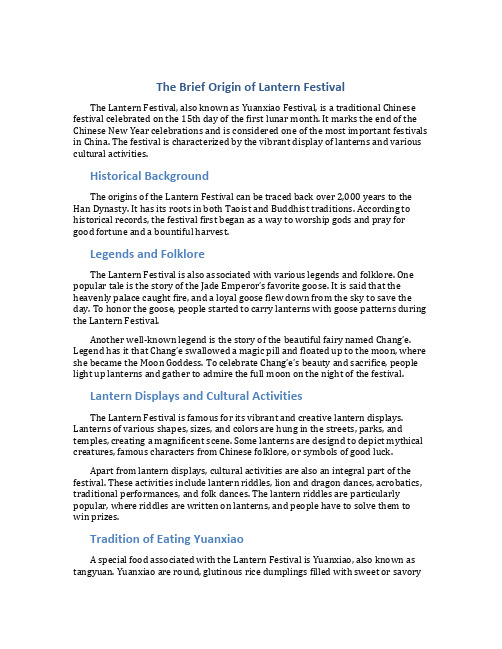
The Brief Origin of Lantern FestivalThe Lantern Festival, also known as Yuanxiao Festival, is a traditional Chinese festival celebrated on the 15th day of the first lunar month. It marks the end of the Chinese New Year celebrations and is considered one of the most important festivals in China. The festival is characterized by the vibrant display of lanterns and various cultural activities.Historical BackgroundThe origins of the Lantern Festival can be traced back over 2,000 years to the Han Dynasty. It has its roots in both Taoist and Buddhist traditions. According to historical records, the festival first began as a way to worship gods and pray for good fortune and a bountiful harvest.Legends and FolkloreThe Lantern Festival is also associated with various legends and folklore. One popul ar tale is the story of the Jade Emperor’s favorite goose. It is said that the heavenly palace caught fire, and a loyal goose flew down from the sky to save the day. To honor the goose, people started to carry lanterns with goose patterns during the Lantern Festival.Another well-known legend is the story of the beautiful fairy named Chang’e. Legend has it that Chang’e swallowed a magic pill and floated up to the moon, where she became the Moon Goddess. To celebrate Chang’e’s beauty and sacrifice, people light up lanterns and gather to admire the full moon on the night of the festival.Lantern Displays and Cultural ActivitiesThe Lantern Festival is famous for its vibrant and creative lantern displays. Lanterns of various shapes, sizes, and colors are hung in the streets, parks, and temples, creating a magnificent scene. Some lanterns are designd to depict mythical creatures, famous characters from Chinese folklore, or symbols of good luck.Apart from lantern displays, cultural activities are also an integral part of the festival. These activities include lantern riddles, lion and dragon dances, acrobatics, traditional performances, and folk dances. The lantern riddles are particularly popular, where riddles are written on lanterns, and people have to solve them to win prizes.Tradition of Eating YuanxiaoA special food associated with the Lantern Festival is Yuanxiao, also known as tangyuan. Yuanxiao are round, glutinous rice dumplings filled with sweet or savoryingredients like red bean paste, sesame paste, and minced meat. The round shape of the dumplings symbolizes completeness and reunion.Eating Yuanxiao has become a common tradition during the festival. Families gather together to make and enjoy these dumplings as a way of expressing good wishes for the coming year. It is also believed that by eating Yuanxiao, one can add a year to their age, signifying the growth and renewal of life.ConclusionThe Lantern Festival, with its rich history and cultural significance, has become a beloved tradition observed by Chinese people around the world. It not only provides an opportunity for people to showcase their creativity through lantern displays but also serves as a time for families to come together, enjoy delicious food, and celebrate the arrival of spring. The festival highlights the importance of unity, good fortune, and the renewal of life.。
英语元宵节来历

英语元宵节来历The Lantern Festival, also known as Yuanxiao Festival, is a traditional Chinese festival that falls on the fifteenth day of the first month in the lunar calendar. It marks the end of the Chinese New Year celebrations, and is a time for family reunions and joyful gatherings. People celebrate by eating tangyuan (sweet rice balls), admiring lanterns, watching lion dances, and setting off fireworks.元宵节,又称为灯节,是中国的传统节日,庆祝时间在农历正月十五日。
它标志着中国新年庆祝活动的结束,是一个家庭团聚和愉快聚会的时刻。
人们通过吃汤圆(甜米球)、赏灯笼、观赏舞狮和放烟花来庆祝这一节日。
The origins of the Lantern Festival can be traced back to over 2000 years ago in the Western Han Dynasty. It is said that the festival was first introduced by Emperor Ming of Han, who wanted to honor Taiyi, the ancient god of heaven. To show respect, people would fix lanterns on the fifteenth day of the first lunar month.灯节的起源可以追溯到2000多年前的西汉时期。
元宵节的来历英语

元宵节的来历英语元宵节的来历英语because the first lunar month is called yuan-month and in the ancient times people called night Xiao. The 15th day is the first night to see a full moon. So the day is also called Yuan Xiao Festival in China.According to the Chinese tradition, at the very beginning of a new year, when there is a bright full moon hanging in the sky, there should be thousands of colorful lanterns hung out for people to appreciate. At this time, people will try to solve the puzzles on the lanterns and eat yuanxiao (glutinous rice ball) and get all their families united in the joyful atmosphere.元宵节正月十五吃元宵的的习俗由来已久,元宵也叫“汤圆”、“圆子”。
据说元宵象征合家团圆,吃元宵意味新的一年合家幸福、万事如意。
元宵节闹花灯的习俗起源于道教的“三元说”;正月十五日为上元节,七月十五日为中元节,十月十五日为下元节。
主管上、中、下三元的分别为天、地、人三官,天官喜乐,故上元节要燃灯。
元宵节的节期与节俗活动,是随历史的发展而延长、扩展的。
就节期长短而言,汉代才一天,到唐代已为三天,宋代则长达五天,明代更是自初八点灯,一直到正月十七的夜里才落灯,整整十天。
- 1、下载文档前请自行甄别文档内容的完整性,平台不提供额外的编辑、内容补充、找答案等附加服务。
- 2、"仅部分预览"的文档,不可在线预览部分如存在完整性等问题,可反馈申请退款(可完整预览的文档不适用该条件!)。
- 3、如文档侵犯您的权益,请联系客服反馈,我们会尽快为您处理(人工客服工作时间:9:00-18:30)。
元宵节来历英语【篇一:元宵节lantern festival由来中英文翻译】元宵节自汉朝(公元前206年—公元221年)起,元宵节就已成为了中国新年庆祝活动中的一部分了。
一般农历的正月十五为元宵节,这一天也标志着新年庆祝活动的结束。
the lantern festival has been part of chinese new year celebrations since the han dynasty (206 bc- 221 ad). usuallyheld on the 15th day of the first month of the lunar calendar, it marks the end of new year festivities。
据说元宵节由古代中国的一个传说演化而来,传言每至农历第一个月圆之夜,便可看到天上飞动的神灵。
为了更容易寻找神灵,他们都会用一些火把照明,而这些火把也逐渐由一些形状、大小、颜色各异的灯笼所取代。
it is said that the holiday evolved from an ancient chinese belief that celestial spirits could be seen flying about in thelight of the first full moon of the lunar calendar. to aid them in their search for the spirits they used torches. these torches gave way to lanterns of every shape, size and colour。
元宵节广受喜爱的另一个原因在于:它也被看做中国的情人节,因为在过去,这一天少男少女们可以利用这个宝贵的机会晚上一起出去约会。
而今,在中国、香港、新加坡和台湾每年都会欢庆元宵节,以此作为中国新年庆祝的收尾。
同时这些地方每年也会举办一些比赛来评选最佳彩灯。
the lantern festival is also popularly referred to as the chinese valentine’s day because in days of old it gave girls and boys a rare chance to go out in the evening and mingle. today, lantern festivals are held each year in china, hong kong, singaporeand taiwan to mark the end of chinese new year celebrations. competitions are held to select the best lanterns。
灯笼灯笼的形状各异,大小不同。
一些灯笼会扎成动物、昆虫、花朵、人甚至是机器或建筑物的形状。
还有一些则描绘了许多广为流传故事的情景,用来宣扬孝道以及传统价值观。
最受大众喜爱则为当年生肖动物的主题彩灯,2014年会是马年。
the lanternsthe lanterns come in all shapes and sizes. some are created in the form of animals, insects, flowers, people or even machines or buildings. others depict scenes from popular stories teaching filial piety and traditional values. a favourite subject is the zodiac animal of the year猜灯谜元宵节传统习俗中还有一部分是关于猜灯谜的游戏。
在过去,这些谜语大多出自于模糊的文学典故和中国古典之中,所以猜灯谜以前多为知识份子的“领地”。
lantern riddles (caideng mi)part of the lantern festival tradition involves a game to guess riddles attached to the lanterns. in the old days the riddles were obscure literary allusions to the chinese classics and so were mainly the preserve of the educated classes。
特色小吃与大多数中国节日一样,元宵节同样有自己的特色小吃,称为“汤圆”(也叫“元宵”)。
汤圆外形圆圆的,外皮由糯米制成,内馅或甜或辣。
人们都说汤圆有两个象征之意,一为农历的第一个月圆,二为家庭团聚圆满。
special foodslike most chinese festivals, the lantern festival has its own special food, called tang yuan. these are round, glutinous rice dumplings with sweet or spicy fillings. the dumplings are said to symbolise both the first full moon and family unity and completeness。
【篇二:中国民俗-元宵节英文介绍】段落翻译b-中国民俗-元宵节-综述-4中文:元宵节(the lantern festival)是中国农历正月的第十五天,这是新年的第一次满月,象征着和睦团圆。
元宵节是家庭团聚的传统佳节,最隆重的活动就是展挂各种各样的灯笼。
元宵节晚上,大街小巷挂满了各式各样的灯笼。
人们走上街头,观看舞狮表演、猜灯谜(guessing lantern riddles)、放烟花,老少欢聚,其乐融融。
元宵节标志着春节的结束,元宵之后,人们的生活回归到日常状态。
语言要点:symbolize, harmony, family reunion, streets and lanes, mark, daily routine译文:the lantern festival falls on the 15th day of the first lunar month. this is the first full moon of the new year, symbolizing harmony and reunion. it is traditionally a time for family reunion. the most prominent activity of the festival is the display of all types of beautiful lanterns. on that night, streets and lanes are decorated with a variety of lanterns. people gather in the streets, watching dragon dance, guessing lantern riddles, and lighting fireworks. it’s really a lot of fun for the old and the young. the lantern festival marks the end of the new year season and afterwards life returns to daily routine.【篇三:元宵节的来历习俗意义英文】元宵节的来历习俗意义英文until the sui dynasty in the sixth century, emperor yangdi invited envoys from other countries to china to see the colorful lighted lanterns and enjoy the gala(节日的,庆祝的)performances.by the beginning of the tang dynasty in the seventh century, the lantern displays would last three days.the emperor also lifted the curfew(宵禁令), allowing the people to enjoy the festive lanterns day and night. it is not difficult to find chinese poems which describe this happy scene.in the song dynasty, the festival was celebrated for five daysand the activities began to spread to many of the big cities in china. colorful glass and even jade were used to make lanterns, with figures from folk tales painted on the lanterns.however, the largest lantern festival celebration took place in the early part of the 15th century. the festivities continued for ten days. emperor chengzu had the downtown area set asideas a center for displaying the lanterns. even today, there is a place in beijingcalled dengshikou. in chinese, deng means lantern and shi is market. the area became a market where lanterns were sold during the day. in the evening, the local people would go there to see the beautiful lighted lanterns on display.today, the displaying of lanterns is still a big event on the 15th day of the first lunar month throughout china. people enjoy the brightly lit night. chengdu in southwest chinas sichuan province, for example, holds a lantern fair each year in the cultural park. during the lantern festival, the park is literally an ocean ofw designs attract countless visitors. the most eye-catching lantern is the dragon pole. this is a lantern in the shape of a golden dragon, spiraling up a 27-meter -high pole, spewing fireworks from its mouth. it is quite an impressive sight!。
